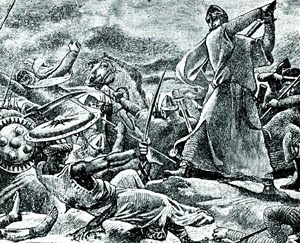(Take a few steps back into the glorious history of Catholic Spain, and read this story of Catholic daring.)
When the Moorish knights beheld that all courteous challenges were unavailing, they sought various means to provoke the Christian warrior to the field. Sometimes a body of them, fleetly mounted, would gallop up to the skirts of the camp, and try who should hurl his lance farthest within the barriers, having his name inscribed upon it, or a label affixed, containing some taunting defiance. These bravados caused great irritation; still the Spanish warriors were restrained by the prohibition of [king Ferdinand].
Among the Moorish cavaliers was one named Tarfe, renowned for strength and daring spirit; but whose courage partook of fierce audacity, rather than chivalric heroism. In one of these sallies, when skirting the Christian camp, this arrogant Moor outstripped his companions, overleaped the barriers, and, galloping close to the royal quarters, launched his lance so far within, that it remained quivering in the earth close by the pavilions of the sovereigns.
The royal guards rushed forth in pursuit, but the Moorish horsemen were already beyond the camp, and scouring in a cloud of dust for the city. Upon wresting the lance from the earth, a label was found upon it, importing that it was intended for [Queen Isabella].
Nothing could equal the indignation of the Christian warriors, at the insolence of the bravado, and the discourteous insult offered to the queen. Hernan Perez del Pulgar, surnamed “he of the exploits,” was present, and resolved not to be outbraved by this daring infidel. “Who will stand by me,” said he, “in an enterprise of desperate peril?” The Christian cavaliers well knew that harebrained valor of Hernan, yet not one hesitated to step forward. He chose fifteen companions, all of powerful arm and dauntless heart.
Hernán Pérez del Pulgar nailing the words Ave Maria to the door of the Mosque.
His project was to penetrate Granada in the dead of the night, by a secret pass, made known to him by a Moorish renegade of the city, whom he had christened Pedro Pulgar, and who was to act as guide. They were to set fire to the Alcaiceria and other principal edifices, and then effect their retreat as best they might. At the hour appointed, the adventurous troop set forth provided with combustibles. The renegade led them silently to a drain or channel of the river Darro, up which they proceeded cautiously, single file, until they halted under a bridge near the royal gate. Here dismounting, Pulgar stationed six of his companions to remain silent and motionless and keep guard, while followed by the rest, and still guided by the renegade, he continued up the drain or channel of the Darro, which passes under a part of the city, and was thus enabled to make his way undiscovered into the streets. All was dark and silent. At the command of Pulgar, the renegade led him to the principal mosque.
Here the cavalier, pious as brave, threw himself on his knees, and drawing forth a parchment scroll on which was inscribed in large letters AVE MARIA, nailed it to the door of the mosque, thus converting the heathen edifice into a Christian chapel and dedicating it to the Blessed Virgin. This done, he hastend to the Alcaiceria to set it in a blaze. The combusibles were all placed, but Tristan de Montemayor, who had charge of the firebrand, had carelessly left it at the door of the mosque. It was too late to return there. Pulgar was endeavoring to strike fire with flint and steel into the raveled end of a cord, when he was startled by the approach of the Moorish guard going the rounds. His hand was on his sword in an instant.
Seconded by his brave companions, he assailed the astonished Moors and put them to flight. In a little while the whole city resounded with alarms, soldiers were hurrying through the streets in every direction; but Pulgar, guided by the renegade, made good his retreat by the channel of the Darro, to his companions at the bridge, and all mounting their horses, spurred back to the camp. The Moors were at a loss to imagine the meaning of this wild and apparently fruitless assault; but great was their exasperation, on the following day, when the trophy of hardihood and prowess, the “AVE MARIA,” was discovered thus elevated in bravado in the very center of the city. The mosque thus boldly sanctified by Hernand del Pulgar was actually consecrated into a cathedral, after the capture of Granada.
The words "Ave Maria" are nailed to the Mosque.
Washington Irving, Chronicle of the Conquest of Granada (New York: George P. Putnam, 1850), pp. 489-491.
Short Stories on Honor, Chivalry, and the World of Nobility—no. 149




No comments:
Post a Comment